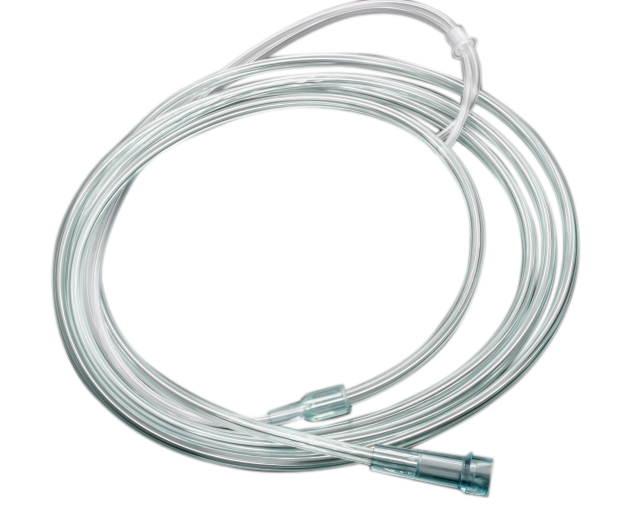
A nasal cannula is a device that’s used to provide oxygen and other medical supplies to people who are unable to breathe on their own. It attaches to the nose and tubing runs down the throat and into the lungs.
| Ref. No.: | Size: | Oxygen Connecting Tube: | Tip Type: | Qty. Cs: |
|---|---|---|---|---|
| NMR101136 | Adult | 7-ft long, transparent | Standard tip | 100 |
| NMR101137 | Child | 7-ft long, transparent | Standard tip | 100 |
| NMR101138 | Infant | 7-ft long, transparent | Standard tip | 100 |
| NMR101139 | Adult | 7-ft long, transparent | Flared tip | 100 |
| NMR101106 | Adult | 7-ft long, green | Standard tip | 100 |
| NMR101107 | Child | 7-ft long, green | Standard tip | 100 |
| NMR101108 | Infant | 7-ft long, green | Standard tip | 100 |
| NMR101109 | Adult | 7-ft long, green | Flared tip | 100 |
A nasal cannula is a device that’s used to provide oxygen and other medical supplies to people who are unable to breathe on their own. It attaches to the nose and tubing runs down the throat and into the lungs.
A nasal cannula is a thin, tube-like device that is inserted into your nose through the nose or mouth. It's used to provide oxygen and other necessary air during certain medical procedures.
Nasal cannula tips come in a variety of shapes, sizes and materials, including silicone, metal, plastic and jelly. They also come in different colors so you can easily tell them apart from each other during surgery.
The standard nasal cannula tip is made of polished metal and comes in either a short or long style. The short style is usually used for children and the long style is used for adults.
There are also specialty nasal cannula tips, such as a naso-gastric (NG) tip, which are designed to be inserted through the nose and into the stomach. NG tips are sometimes used during stomach surgeries to allow surgeons to directly access the stomach without having to go through the chest.
Choosing the right nasal cannula tip is important because it can affect how well the device works and how comfortable you are during surgery. Your doctor will ask you about your preferences before making any decisions about what type of tip to use.
Knowing how to use a nasal cannula is essential for those who have difficulty breathing through their nose. The nasal cannula is a tube that is inserted into the nose and passed through the mouth to the throat. This allows people with respiratory difficulties to breathe through their noses. There are three main types of nasal cannulas: standard, lumen, and dual lumen. Each has its own set of instructions for use.
To use a standard nasal cannula, first make sure that your nose is properly cleaned. Next, cut off the end of the cannula so that it is about two inches long. Put the end of the cannula into your nose and push it all the way up until it touches your forehead. Make sure that your chin is tucked in so that you do notrisk drooling down your throat. Finally, hold your breath and slide the cannula all the way down your throat until it comes out of your mouth.
To use a lumen nasal cannula, open wide your mouth by sticking out your tongue. Insert the end of the cannula all the way into one side of your mouth and then suck on it until it goes all the way in. Hold your breath and slide the cannula
Nasal cannulas are commonly used in the medical community to provide relief from nasal congestion. Nasal cannulas come in a variety of sizes and tips, allowing patients to find the one that works best for them. Here are some of the benefits of using a nasal cannula:
-It can help relieve congestion and improve breathing.
-It is portable, so you can take it with you wherever you go.
-It is affordable, making it a good option for people with limited budgets.
When your nasal cannula is not in use, it is important to keep it clean and dry. Make sure the tubing is properly stored when not in use. If the cannula becomes dirty, rinse it off with warm water and soap. Pat it dry with a clean cloth. Do not use harsh chemicals or solvents on the cannula.